Culture
Bhawanis Of Bhuchar Mori: Setting A World Record In Talwaar Raas Has Ignited Passion For Sword Fighting In Gujarat’s Rajput Women
Sumati Mehrishi
Sep 28, 2019, 04:47 PM | Updated 04:47 PM IST
Save & read from anywhere!
Bookmark stories for easy access on any device or the Swarajya app.
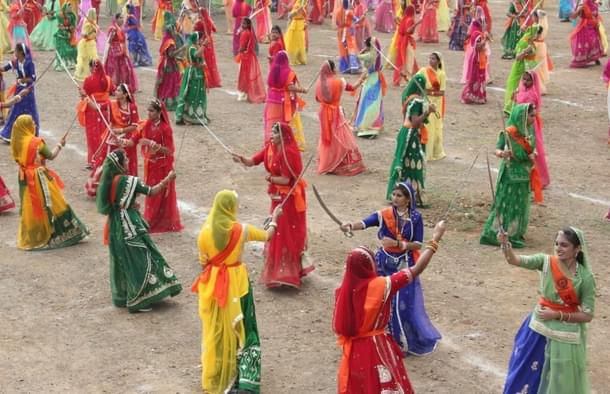
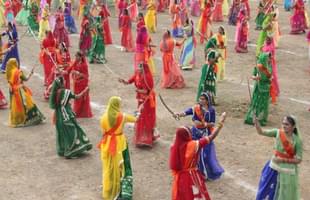
In August this year, 2,300 Rajput women paid tribute to a dharmyuddh fought against the Mughals. The tribute could have been paid by a lesser number of women participants, yet an ambitious show and statement of strength was invoked, registered and recorded.
The women created a world record by performing talwaar raas — a form of raas — at the historic and blood-drenched Bhuchar Mori grounds in Jamnagar's Dhrol tehsil. At the centre of this tribute was the weapon, and the pride in the community.
Talwaar raas is often performed along with garbha, during Navratri annually as a homage to the sacrifice and valour of Rajput soldiers in Gujarat, especially in Saurashtra.
The grand performance was held at the Bhuchar Mori grounds in August. To the men and women of the community watching the historic feat unfolding before them, it was an emotional moment.
Present among the audience was union minister (Retired) General V K Singh — himself a warrior. For every Rajputani performing the raas on the ground, Singh's presence became the driving force to complete the emotion-marked drill to perfection.
The edge of the bare sword glistened in her bangled hands. The steely cries of "Jai Bhawani", which is also a war cry, grew louder as she moved her wrist. The weapon moved and cut the air to the rhythm of the raas.
Rehearsing in the harsh Saurashtra sun had toughened her for the final day and for the crucial performance, and so, the bold moves of the sword fell swiftly from her right arm. The nathani (the traditional nose ring), the forehead ornaments and the sword — they glittered against her subdued brilliance.
She is believed to have taken some of this courage from her own mother and some from Ma Bhawani — as Durga is addressed sometimes. The sword is the symbol of her valour. And when she holds the sword, her courage soars even higher.
To those watching her, valour arrives, but it arrives in duality. Part of it arrives with the sword that she is carrying, and part of it from the Rajputani herself. "Jai Bhawani", she yells, raising the sword.
A manifestation of Bhavani she herself becomes. She is about courage, beauty, grace, ferocity and focus on the battlefield — an amalgamation of all virtues that define a true Rajput woman.
It was this aspect in the celebration of Rajput valour through talwaar raaas that pushed Dr Jayendrasinghji Jadeja, who heads the Akhil Gujarat Rajput Yuva Sangh, to gather 2,000 women for a mass performance on the grounds of Bhuchar Mori.
He says, "We Rajputs consider talwaar our Devi. So when a Rajput woman holds a sword we see it as the meeting of shakti and shakti."
"Jai Bhawani!" The men from her community yelled out of respect for her. Each time she shuffled and shifted through the dust for a new sword movement, delivered in a swift swoosh, the men assembled at Bhuchar Mori grounds, who were the audience that day, encouraged her. How? They shouted, "Jai Bhawani!"
The number of women participants for this event exceeded the expectations of the Akhil Gujarat Rajput Yuva Sangh — the force behind the event. In fact, the Sangh had to turn away many women who had wished to participate.
Such was the passion in the Rajputanis to create a memorable performance with talwaar raas — a celebration of the Devi by two of her manifestations — the woman and the sword!
During the nomination process, the organisers were told that this act could cause injuries. It did not go down well with Jadeja. He says, "I told them that their view is insulting. Even a five-year-old plays with the sword. Rajput women are known for their courage."
Preparing The Pitch For Gujarat Rajputanis
Since August this year, renowned Gujarati choreographer J C Jadeja's phone hasn't stopped ringing. He is the man who packed this powerful performance in an aesthetic presentation through a choreography.
Jamnagar district is considered the natural home for talwaar raas, and the performance of talwaar raas marks many occasions here, done in honour of the brave warriors every year. It also helped that J C Jadeja is based in Jamnagar.
The Rajput women address Jadeja as "bapu" — a title used for father, in Gujarat. Some Rajput women want to have another chance at such a feat. Others want to make a beginning in performing talwaar raas on the scale and intensity that was exhibited on the grounds of Bhuchar Mori.
Raas is a folk performing art dedicated to the celebration of Janmashtami and in Gujarat, the celebration of Navratri as well.
When Rajput women perform raas, particularly talwaar raas, they completely transform the idea of the gender-related perception of the raas as seen in other states, especially Uttar Pradesh, where it is performed in the bhakti, love and romance for Krishna.
In commemoration of the bravery and sacrifice of Rajputs who fought against the tyrannical might of Akbar's forces, raas, when performed using swords, scuttles to the background, remaining as the framework of a brave expression of gender and community pride.
The feminine aspect in the talwaar, the sword, arises as brilliantly as the woman who is holding and moving it.
At Bhuchar Mori's talwaar raas in August, there were rows and rows of Rajput women representing 16 districts of Gujarat.
The preparation took about two months. Women were trained in different districts by Jadeja for 15 days. Swords were sourced from Kutch. When not enough, more were sourced from Punjab.
The biggest challenge before the organisers was that women participants were spread across 16 districts in Gujarat.
To tackle this, J C Jadeja was helped by Jaidevsinghji Gohil, another representative of Rajput Yuva Sangh and an expert in talwaar raas, in helping participants converge for practice.
Clusters were formed. For example, Rajput women from Mahesana, Patan and Banaskaantha practiced in a village in Patan.
In Honour Of Jam Sataji's Resistance To Akbar's Might
The dharmayuddha of Bhuchar Mori fought in Vikram Samvat 1648 (Gregorian year 1591) widowed thousands of Rajput women.
The talwaar raas is also a strong symbol to signify their continuity in the painful separation from their beloved — those fallen on the battle-ground — a way to narrate what had happened at the battle.
The fierce battle of Bhuchar Mori saw the forces of Akbar attacking Nawanagar to fight Jam Sataji, who was the ruler of the Nawanagar state. Events related to the battle are part of Rajput oral and written history and tradition.
Dr Jayendrasinghji Jadeja says, "The bone of contention between Jam Sataji and Akbar was Sultan of Gujarat Muzafar Shah III — who had lost a battle against Akbar and as a result was seeking asylum. Jam Sataji, going by Rajput values, and true to his dharma, offered him asylum. Unhone Muzafar Shah III ko sharan dee."
The Mughal ruler got angered by Jam Sataji's move. He ordered the capturing of Shah and for this, he ordered Mirza Aziz Kokah, his man governing in Gujarat, to charge towards Nawanagar with all force and might. Jam Sataji's forces put up a brave fight against Akbar's.
The blood bath and resistance from the Rajputs that followed gave this battle the title of "Panipat of Saurashtra".
"Akbar feared Jam Sataji. Though the Mughal king won the battle eventually, Jam Sataji's courage and sacrifice came to define him and Rajputs," Jayendrasinghji Jadeja adds.
The foundation stone for the Bhuchar Mori Maha Yuddh memorial in Dhrol, which was developed with contributions from Akhil Gujarat Rajput Yuva Sangh and Bhuchar Mori Shahid Smarak Trust, was laid by the then chief minister, Narendra Modi.
The grounds have been the fertile venue for cultural commemoration of the braves through various traditional performances, including the talwaar raas.
Organisers of the event feel that there couldn't have been a better tribute to the great Jam Sataji than having the Rajputanis descend on the battlefield for talwaar raas. "The world record is set. We are determined to do more," Jayendrasinghji Jadeja adds.
The Footwork, Swordwork And Clockwork
Participants have been issued certificates for featuring in the world record feat by the organisers.
Ideally, the excitement should have subsided by now. But that hasn't happened. The event has ignited the appetite in the women for improving their skills and performance, and more importantly, for continuing the practice.
But how was the world record aimed for in movement and clockwork?
Once Jadeja and Gohil worked out the basic framework of the choreography, they put it together for oral training. Some of it was recorded in videos. Then, they set out on their journey for direct training. The journey would sometimes mean traveling 350 km for one lesson.
Movements were broken down into hand and leg movements minus the sword. It isn't as easy as it sounds. According to Gohil, the hand movements were established first, then the combination of hand and leg movements, and last, the sword was fused into the hand and leg movements.
The other problem was the lack of confidence in the women regarding their own sword-wielding skills. Gohil adds, "Sword-wielding is in their blood. It doesn't matter whether they are used to holding a pen or a kitchen utensil.
“You hand over a sword to a Rajput woman and she will pick its movement in no time. But there were some participants who would suddenly hit a low in confidence and say that they won't be able to do it. We had to work on that."
Setting small goals and motivation worked. Gohil would give them simple steps to practice and fix the evening as the deadline for them to translate the movements from thought to action. Once they finished a chunk, their confidence would leap.
More movements would be added and the evening fixed again as the deadline. Gohil would ask for progress updates. And this way, the training sessions moved ahead and culminated into three rigorous rehearsals on the Bhuchar Mori grounds.
According to Gohil, the entire task and exercise has connected the Rajput women once again with a natural instinct to fight, which, in case of many women participants, was used to hone their sword-wielding skills.
The Uniting Song Of Sacrifice
The songs selected for talwaar raas are specific to the Rajput community. This event wasn't an exception.
According to Sharadaba Bharatasinh Jadeja, a senior member of the Rajput community from Ahmedabad, the talwaar raas songs commemorate the brave men who went away to fight; they reflect the conversations between the man and the woman.
The man mentions how he must be remembered when he has died fighting the enemy.
Sharadaba says, "In the song, the man mentions the paaliya, the memorial stone, the falling of tears on the stone in his memory by those who grieve and mourn him. He also mentions his unborn child, and goes on to tell his pregnant wife how their child, once born, should be made to visit the paaliya."
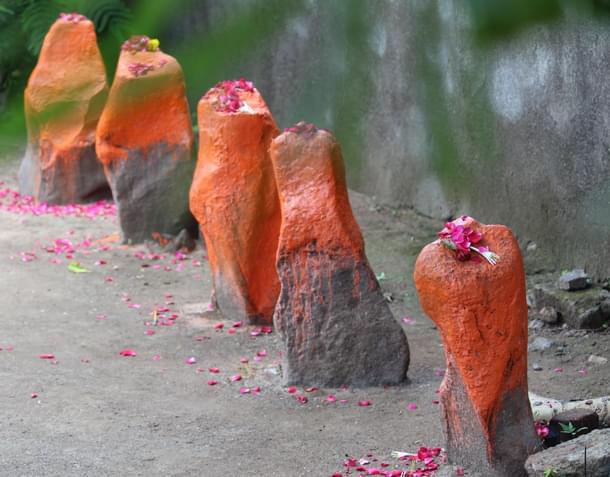
Though the colour smeared on the paaliyas is that of sacrifice, one of the songs, according to Jadeja, even mentions the brave man telling his wife that his paaliya should not be smeared with the colour, but marked by the tears of those who visit it.
The singing on the day of the final performance filled the Shaheed Van in Dhrol, as did the sound of the banjo.
The use of the banjo, a stringed musical instrument, is prevalent in garba songs and songs meant to commemorate the brave and war, as also during the talwaar raas in Gujarat. Interestingly, it is so in parts of Rajasthan, Uttar Pradesh and Punjab too.
According to Sharadaba Jadeja, older women among the participants were particularly touched by the emotional meaning of the event. "They said that they got aatmasantosh — inner satisfaction — in seeing the women of three generations perform the talwaar raas together."
As seen in the 10-minute long video, the performance is roughly divided into two different paces and parts. The first part, which opens to the cries of "Jai Bhavani" is slower in pace, and the sword work is slower too, as variations progress gradually. The song times it.
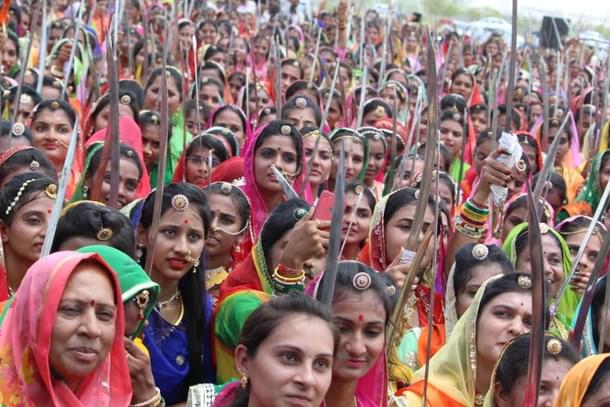
Each new variation is more complex than the previous. By about two minutes into the performance, the rhythm of footwork is set and in flow.
The swinging of the sword becomes even more complex, along with the turning of the body. The participants change direction. The variety of moments rest completely on the deftness of the wrist. The left-hand remains glued to the right side of the participant's waist, maintaining a soft hold, throughout.
Then, there is a solemn pause. The music to which they are performing the raas, fades. The women kneel and pay their respects to the sword.
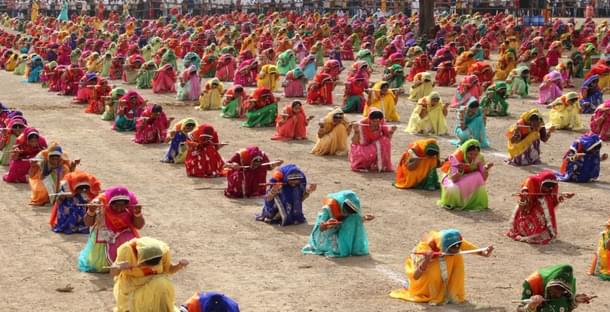
This is followed by a cry: "Bhuchar Mori na shaheedon, amar raho (long live the shaheeds of Bhuchar Mori)."
For the younger women who were part of the performance, it was an opportunity to rise to a tradition — of Rajput pride and self-defense. Jayendrasinghji Jadeja adds, "Women must know how to protect themselves."
Rajputs believe in reflecting on history with action. Rajput women of Gujarat have shown that by turning to their history, they are not ready to recoil into inaction. Talwaar raas is a language they have revived to deliver this feisty message.
Sumati Mehrishi is Senior Editor, Swarajya. She tweets at @sumati_mehrishi





